Developing an effective content marketing strategy is crucial for businesses to engage their target audience, build brand awareness, and drive conversions. It helps establish credibility, provide value, and establish a strong online presence in a competitive digital landscape.
Did you know that content marketing generates three times more leads than traditional outbound marketing? With the ever-increasing competition for attention in the online world, businesses are turning to content marketing to engage their target audience and drive meaningful results.
But what does it take to develop an effective content marketing strategy that stands out from the crowd? So, if you're ready to revolutionize your content marketing game, let's embark on this journey together and transform your business's online presence.
Understanding Your Unique Audience
To develop an effective content marketing strategy, it's vital to gain a deep understanding of your specific target audience. One size does not fit all when it comes to content, so it's crucial to tailor your messaging to resonate with your audience's preferences, needs, and pain points.
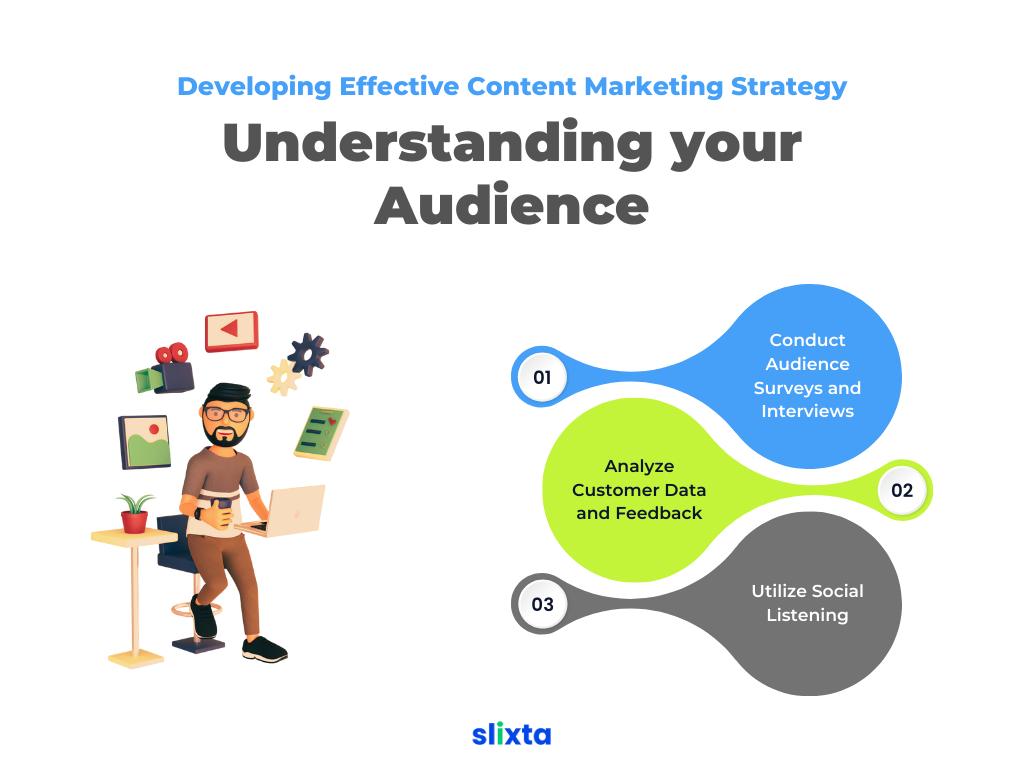
Here's how you can achieve a better understanding:
Conduct Audience Surveys and Interviews
Engage with your existing customers and target audience through surveys and interviews to gather valuable insights. Ask them about their challenges, goals, preferences, and content consumption habits. This will help you create content that directly addresses their needs.
Example: Let's say you're a fashion e-commerce company targeting millennials. Conduct surveys and interviews to understand their fashion preferences, shopping behaviors, and what type of content they find valuable, such as style guides, fashion tips, or behind-the-scenes looks at fashion events.
Analyze Customer Data and Feedback
Dive into your customer data to gain insights into their behavior patterns, purchase history, and engagement metrics. Leverage tools like customer relationship management (CRM) software, Google Analytics, or social media analytics to identify trends and understand what type of content drives conversions and engagement.
Example: An online fitness platform can analyze user data to identify the most popular workout routines, nutritional content, or success stories. By understanding what resonates with their users, they can create more targeted and impactful content.
Utilize Social Listening
Monitor social media platforms, online communities, and forums to listen to conversations related to your industry or niche. Look for discussions, comments, or questions that can provide valuable insights into what your audience is seeking and the content gaps that exist.
Example: A technology company can use social listening to identify common pain points or questions related to their product or service. They can then create content that addresses these pain points and positions themselves as helpful resources.
Defining Unique Goals and Key Performance Indicators (KPIs)
To measure the success of your content marketing efforts, it's crucial to define specific goals and relevant KPIs that align with your business objectives.
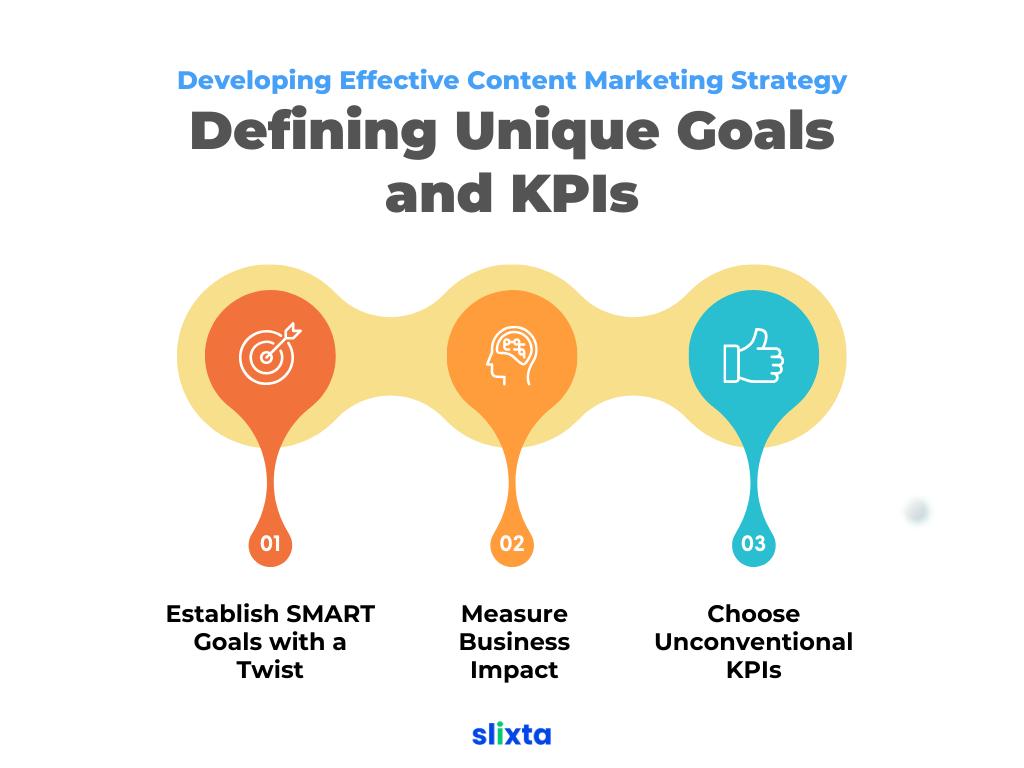
Here's how you can set yourself up for success:
Establish SMART Goals with a Twist
While SMART goals (Specific, Measurable, Attainable, Relevant, and Time-bound) are a standard framework, it's important to add a unique twist to make them more tailored to your business.
Example: Instead of a generic goal like "increase website traffic by 30%," you can set a more specific goal like "increase organic traffic from a specific target audience segment by 30% within six months." This unique twist makes your goal more focused and aligns it with your target audience.
Choose Unconventional KPIs
While traditional KPIs like website traffic and conversion rate are essential, consider incorporating unique KPIs that reflect the specific objectives of your content marketing strategy.
Example: A software company focusing on brand awareness may track metrics like social media sentiment, brand mentions in influential publications or engagement with thought leadership content. These unconventional KPIs provide valuable insights into the impact of their content on brand perception.
Measure Business Impact
Look beyond vanity metrics and tie your content marketing efforts to the broader business impact. Connect your content metrics to revenue generation, customer retention, or customer lifetime value to demonstrate the tangible value of your content marketing strategy.
Example: A SaaS company can track metrics like free trial sign-ups, conversion rates, and customer retention rates to measure the direct impact of their content on the sales funnel and customer acquisition. By aligning their content goals with business outcomes, they can showcase the ROI of their content marketing efforts.
Creating Unique and Engaging Content
Now that you have a solid understanding of your audience and defined goals, it's time to create content that captivates and resonates with your target audience.
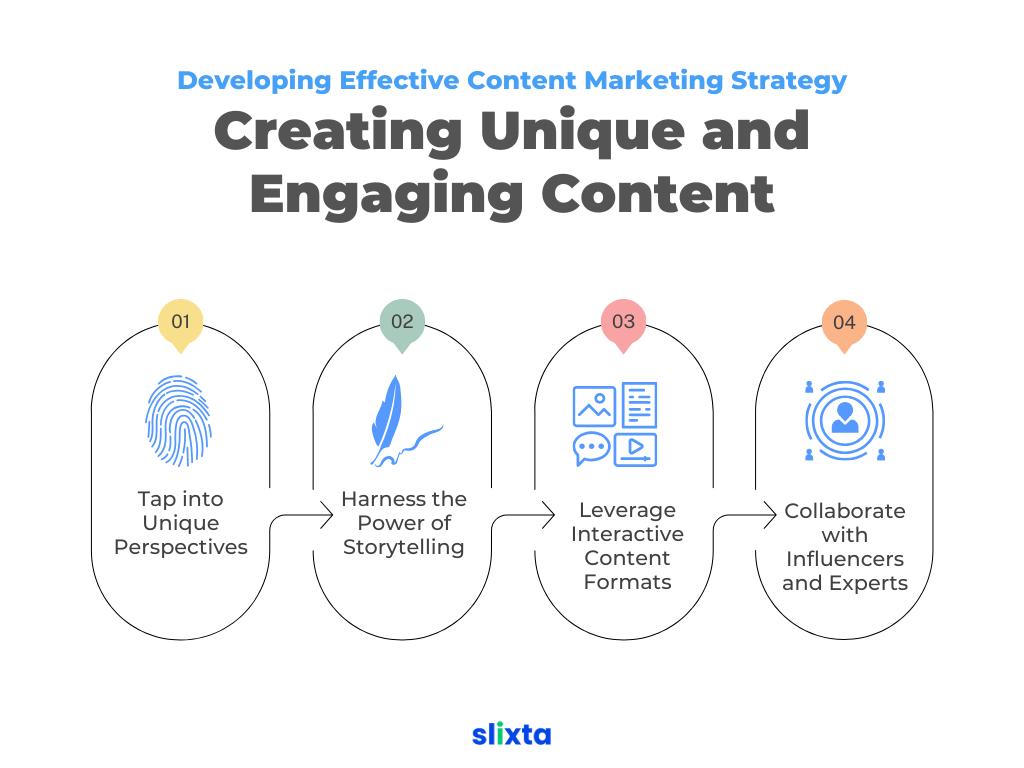
Here are some key tips to make your content stand out:
Tap into Unique Perspectives
Instead of regurgitating common industry topics, strive to bring fresh and unique perspectives to the table. Identify innovative angles, untapped niches, or emerging trends within your industry to differentiate your content.
Example: If you're a travel agency, instead of writing generic destination guides, create content that focuses on offbeat destinations, hidden gems, or sustainable travel practices. This unique perspective will attract a niche audience looking for alternative travel experiences.
Harness the Power of Storytelling
Humans are wired to connect with stories. Weave compelling narratives into your content to evoke emotions, create relatability, and engage your audience on a deeper level. Storytelling can be done through written content, videos, podcasts, or visual graphics.
Example: A nonprofit organization working on environmental conservation can share stories of individuals whose lives have been impacted positively by their initiatives. These personal stories will inspire and emotionally connect with their audience, driving support for their cause.
Leverage Interactive Content Formats
Break away from traditional content formats and incorporate interactive elements that actively engage your audience. Quizzes, polls, interactive infographics, and calculators are effective in capturing attention and increasing user participation.
Example: A financial institution can create an interactive retirement savings calculator that allows users to input their financial information and receive personalized recommendations. This interactive format not only educates the audience but also keeps them engaged and encourages further exploration of the content.
Collaborate with Influencers and Experts
Partnering with influencers and industry experts can add credibility and widen your content's reach. Seek opportunities for guest blogging, interviews, or co-creating content to tap into their established audience base.
Example: A beauty brand can collaborate with a renowned makeup artist to create tutorial videos showcasing their products. By leveraging the expertise and influence of the makeup artist, the brand can reach a wider audience and build trust among its target market.
Promoting and Amplifying Your Unique Content
Creating outstanding content is just the beginning, you also need to ensure that it reaches the right audience.
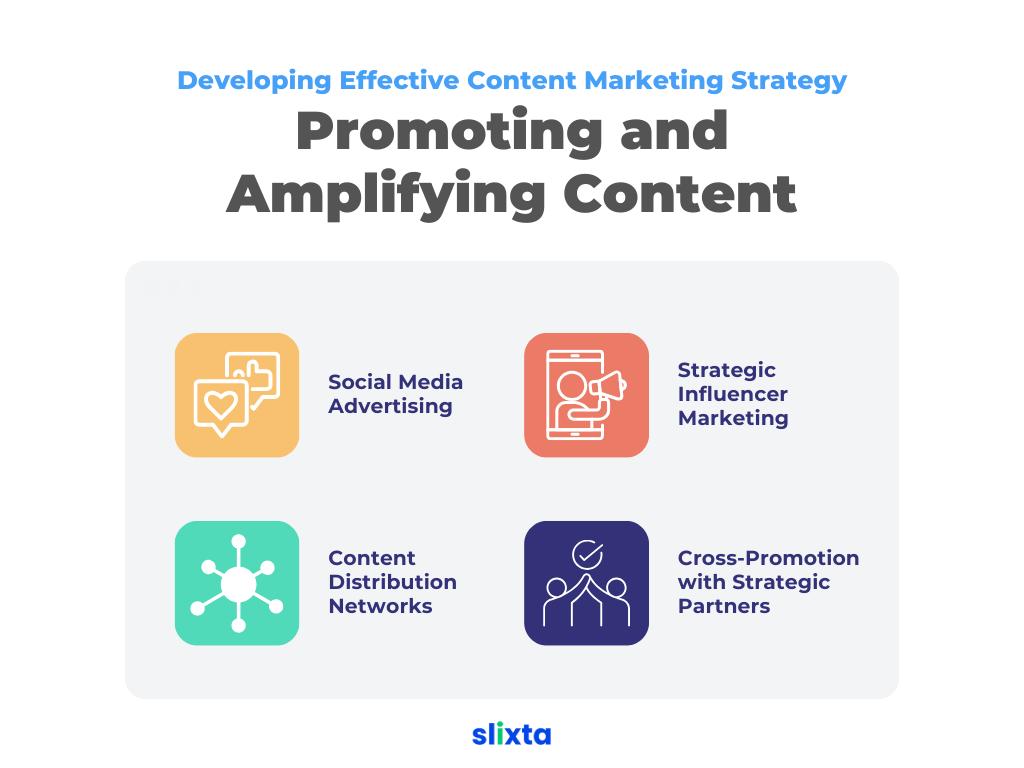
Here are effective strategies to promote and amplify your content:
Social Media Advertising
Utilize targeted social media advertising to reach your specific audience segments. Platforms like Facebook, Instagram, LinkedIn, or Twitter offer advanced targeting options to ensure your content reaches the right people.
Example: A fitness app targeting fitness enthusiasts can run Facebook ads targeting users who have shown an interest in fitness-related pages or have engaged with fitness-related content. This targeted approach maximizes the visibility of their content among their ideal users.
Strategic Influencer Marketing
Identify relevant influencers who align with your brand values and have a genuine connection with your target audience. Collaborate with them to amplify your content to their followers, leveraging their influence and credibility.
Example: A food delivery service can partner with popular food bloggers or Instagram food influencers to showcase their offerings and provide exclusive discounts to their followers. This influencer marketing strategy will expose their brand to a wider audience of food enthusiasts.
Cross-Promotion with Strategic Partners
Forge strategic partnerships with complementary businesses or organizations that share a similar target audience. Together, you can cross-promote each other's content to expand your reach and tap into new audiences.
Example: A fitness apparel brand can partner with a fitness equipment manufacturer to co-create content and cross-promote it on their respective platforms. The apparel brand can feature the equipment in its workout videos, while the equipment manufacturer can showcase the brand's apparel in their product demonstrations. This collaboration introduces both brands to a broader audience interested in fitness and workout gear.
Content Distribution Networks
Utilize content distribution networks such as Outbrain or Taboola to promote your content on high-traffic websites and media publications. These networks allow you to reach a wider audience by displaying your content as recommended or related articles on popular websites.
Example: A technology startup can use content distribution networks to promote their blog posts or whitepapers on renowned technology publications. This increases the visibility of their content and drives traffic back to their website.
Measuring and Optimizing Your Strategy
To ensure the effectiveness of your content marketing strategy, it's crucial to continuously measure and optimize your efforts.
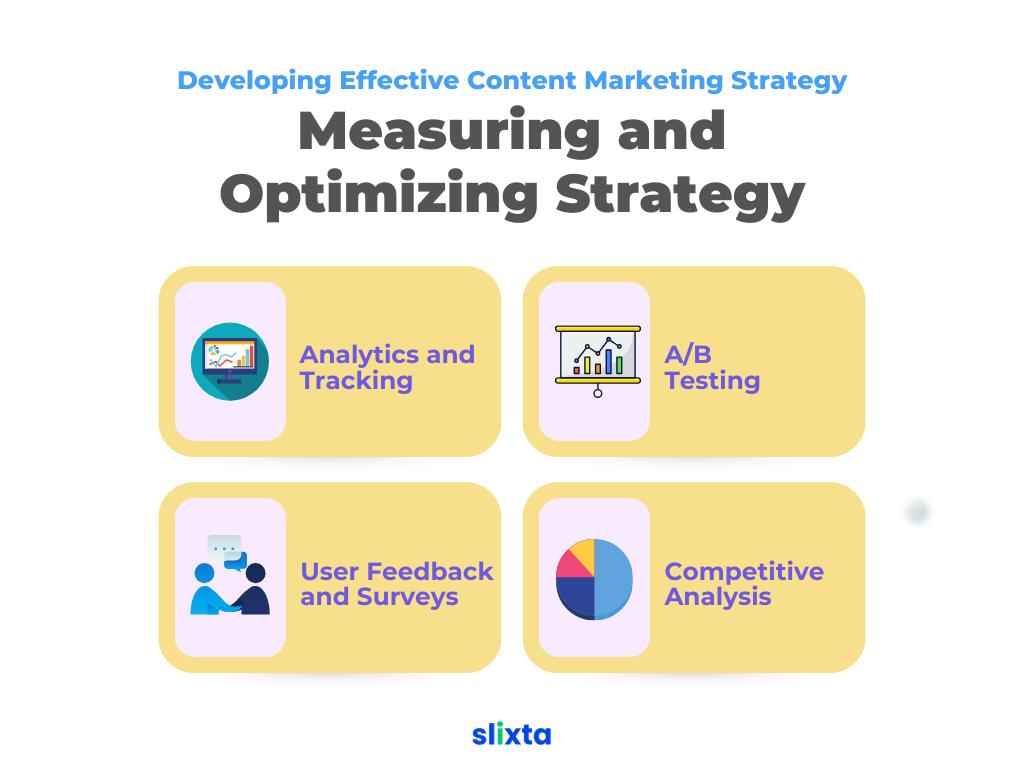
Here are key steps to evaluate and refine your strategy:
Analytics and Tracking
Leverage web analytics tools such as Google Analytics or Adobe Analytics to track key metrics related to your content performance. Monitor metrics like website traffic, time on page, bounce rate, and conversion rates to gain insights into the effectiveness of your content.
Example: An e-commerce company can track the conversion rate of product pages that include detailed, informative content versus those with minimal information. This analysis helps identify the content that drives higher conversions and informs future content creation.
A/B Testing
Conduct A/B tests to compare different variations of your content elements, such as headlines, visuals, calls-to-action, or landing page layouts. This allows you to identify what resonates best with your audience and optimize your content accordingly.
Example: A software company can test two different versions of an email campaign, each with a different subject line and call-to-action. By analyzing the open rates, click-through rates, and conversion rates, they can determine the most effective approach for future campaigns.
User Feedback and Surveys
Actively seek feedback from your audience through comments, surveys, or feedback forms. Engage with your audience to understand their preferences, solicit suggestions, and identify areas for improvement in your content strategy.
Example: An online education platform can include a short survey at the end of their video lessons to gather feedback from learners. This feedback helps them understand the effectiveness of their instructional content and make necessary adjustments.
Competitive Analysis
Keep an eye on your competitors' content marketing strategies and performance. Analyze their content tactics, engagement metrics, and audience feedback to gain insights and identify opportunities for improvement.
Example: A travel agency can analyze the content strategies of their competitors, such as their blog topics, social media engagement, or influencer partnerships. This analysis helps them differentiate their own content and identify gaps in the market.
Conclusion
Developing an effective content marketing strategy requires audience understanding, unique content creation, strategic promotion, and continuous optimization. With Slixta's AI-assisted planner and widget-powered CMS, unlock your brand's full potential. Supercharge your strategy and achieve content marketing success with Slixta.

